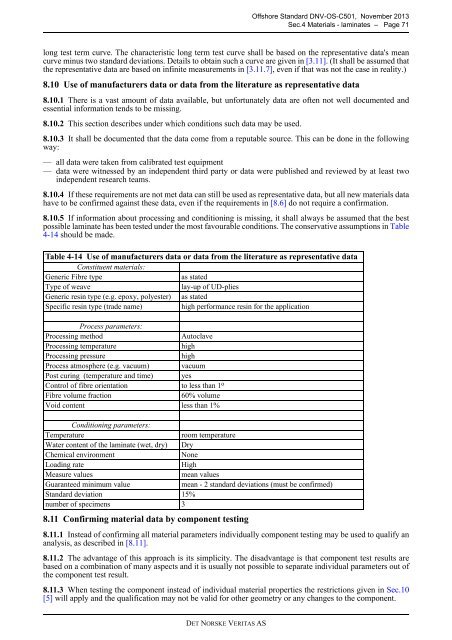OS-C501
You also want an ePaper? Increase the reach of your titles
YUMPU automatically turns print PDFs into web optimized ePapers that Google loves.
Offshore Standard DNV-<strong>OS</strong>-<strong>C501</strong>, November 2013<br />
Sec.4 Materials - laminates – Page 71<br />
long test term curve. The characteristic long term test curve shall be based on the representative data's mean<br />
curve minus two standard deviations. Details to obtain such a curve are given in [3.11]. (It shall be assumed that<br />
the representative data are based on infinite measurements in [3.11.7], even if that was not the case in reality.)<br />
8.10 Use of manufacturers data or data from the literature as representative data<br />
8.10.1 There is a vast amount of data available, but unfortunately data are often not well documented and<br />
essential information tends to be missing.<br />
8.10.2 This section describes under which conditions such data may be used.<br />
8.10.3 It shall be documented that the data come from a reputable source. This can be done in the following<br />
way:<br />
— all data were taken from calibrated test equipment<br />
— data were witnessed by an independent third party or data were published and reviewed by at least two<br />
independent research teams.<br />
8.10.4 If these requirements are not met data can still be used as representative data, but all new materials data<br />
have to be confirmed against these data, even if the requirements in [8.6] do not require a confirmation.<br />
8.10.5 If information about processing and conditioning is missing, it shall always be assumed that the best<br />
possible laminate has been tested under the most favourable conditions. The conservative assumptions in Table<br />
4-14 should be made.<br />
Table 4-14 Use of manufacturers data or data from the literature as representative data<br />
Constituent materials:<br />
Generic Fibre type<br />
as stated<br />
Type of weave<br />
lay-up of UD-plies<br />
Generic resin type (e.g. epoxy, polyester) as stated<br />
Specific resin type (trade name)<br />
high performance resin for the application<br />
Process parameters:<br />
Processing method<br />
Autoclave<br />
Processing temperature<br />
high<br />
Processing pressure<br />
high<br />
Process atmosphere (e.g. vacuum) vacuum<br />
Post curing (temperature and time) yes<br />
Control of fibre orientation<br />
to less than 1 o<br />
Fibre volume fraction<br />
60% volume<br />
Void content less than 1%<br />
Conditioning parameters:<br />
Temperature<br />
room temperature<br />
Water content of the laminate (wet, dry) Dry<br />
Chemical environment<br />
None<br />
Loading rate<br />
High<br />
Measure values<br />
mean values<br />
Guaranteed minimum value<br />
mean - 2 standard deviations (must be confirmed)<br />
Standard deviation 15%<br />
number of specimens 3<br />
8.11 Confirming material data by component testing<br />
8.11.1 Instead of confirming all material parameters individually component testing may be used to qualify an<br />
analysis, as described in [8.11].<br />
8.11.2 The advantage of this approach is its simplicity. The disadvantage is that component test results are<br />
based on a combination of many aspects and it is usually not possible to separate individual parameters out of<br />
the component test result.<br />
8.11.3 When testing the component instead of individual material properties the restrictions given in Sec.10<br />
[5] will apply and the qualification may not be valid for other geometry or any changes to the component.<br />
DET NORSKE VERITAS AS



